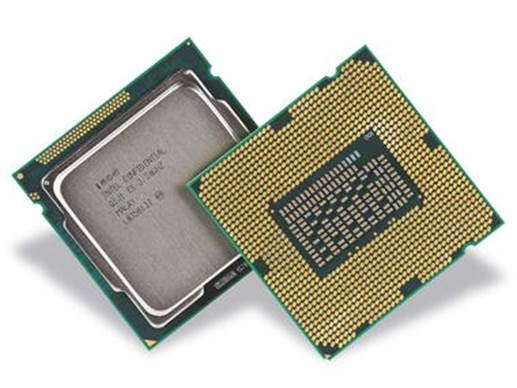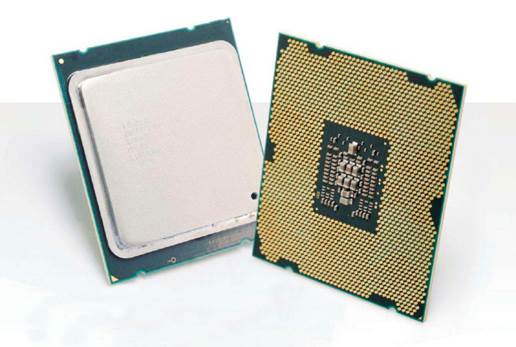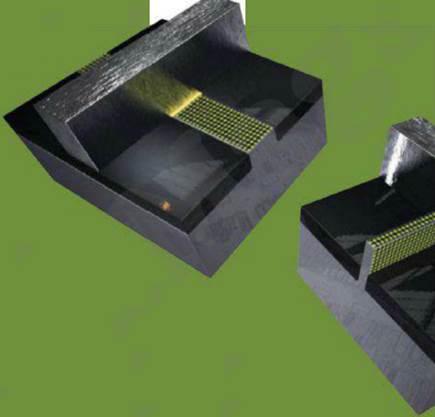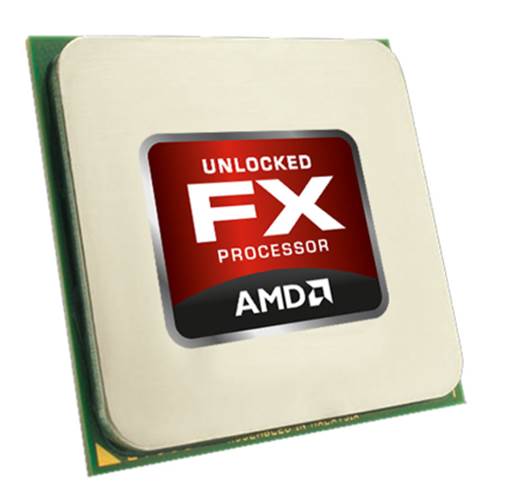Core i7-2600K
§ CPU:
$319
§ Cooler:
$30
§ Radeon
HD 7970: $550
§ 16GB
RAM DDR3/1600 (4x4GB): $94
§ Midrange
Motherboard: $179
§ 2TB
HDD: $200
§ 128GB
SSD: $175
§ Blu-ray
Combo ODD: $60
§ 850-Watt
PSU: $134
§ OS:
$139
§ Total:
$1,880

Intel
Core i7-2600K
Core i7-3820
§ CPU:
$300
§ Cooler:
$30
§ Radeon
HD 7970: $550
§ 16GB
RAM DDR3/1600 (4x4GB): $94
§ Midrange
Motherboard: $329
§ 2TB
HDD: $200
§ 128GB
SSD: $175
§ Blu-ray
Combo ODD: $60
§ 850-Watt
PSU: $134
§ OS:
$139
§ Total:
$2,011

Intel
Core i7 3820
Which is cheaper? We configured two nearly
identical machines with Sandy Bridge and Sandy Bridge-E chips to see how much
of a premium you pay to ride the Sandy Bridge-E train.
It’s not just strictly about prices. The
Core i7-3820 gives you capabilities that Core i7-2600K can’t touch. The most
notable is the availabilities of twice as many DIMMs. This gives you
flexibility in how you configure your system’s RAM. The quad-channel RAM also
gives you roughly twice the memory bandwidth. Core i7-3820 has a leg up with
its PCIe 3.0 support, too. PCIe 3.0 essentially doubles the bandwidth in PCIe
3.0 devices. Most people including us are inclined to pooh-pooh the value of
doubling the PCIe bandwidth, since few devices actually swamp PCIe 2.0, but
apparently it helps. AMD, for example, has said that simply switching a board
from PCIe 2.0 to PCIe 3.0 boost performance from 5 to 10 percent on its Radeon
HD 7970 cards. LGA1155 boards will get their own PCIe 3.0 upgrade, but that
won’t come about until Ivy Bridge is available and will require buying a new
CPU, since the PCIe is controlled from the CPU on Sandy Bridge and Sandy
Bridge-E.
The overview on overclocking
For overclockers, Intel is taking an odd
track with the Sandy Bridge-E chips. Its two hexa-core chips are classified as
K and X parts, respectively, which means they’re fully unlocked chips that let
you change Turbo Boost or clock multipliers at will. The new Core i7-3820
carries no such designation, but Intel says the chip is “partially unlocked”.
Similar to standard Sandy Bridge chips, it features limited overclocking, using
Turbo Boost of up to four bins on all cores. That lets you take the chip to
4GHz. To get further, you’ll have to rely on new block ratios of 125, 166 and
250. Overclocking won’t be quite as straightforward or easy as on a Core
i7-2600K, which can be pushed beyond 4GHz without blinking, but at least it’s
possible.
Making the big decision
What we would pick depends very much on
what we want to do with our system today and tomorrow. A box on LGA1155
definitely gives you a cost advantage that can be used to put in a bigger GPU
or fatter storage. LGA1155 also lets you scale up from sub-$100 Celerons to the
cheap-and-fast $200 Core i5-2500K and then on to a Core i7-2700K. LGA1155 also
isn’t a dead-end, with chips for it using the new 22nm Ivy Bridge on tap for
this spring or summer. Where LGA2011 takes over is in the higher-end enthusiast
segment. Folks who want and need the ability to run six cores will want
LGA2011. It’s also the better platform for anyone who need a ton of PCIe 3.0
lanes to feed fast RAID arrays and GPUs. LGA2011 is also the better option for
anyone who actually needs a ton of RAM. How does Core i7-3820 fit in the
picture? It lets you build into a box that will take you higher up on the power
curve than an LGA1155 system will take you.
Next-gen Intel chip to feature 3D
transistors
If you’re really to jump aboard LGA2011
with a new Core i7-3820, Intel’s upcoming Ivy Bridge CPUs might give you a bit
of pause.
Ivy Bridge chips will be the first CPUs
based on Intel’s new 22nm process using tri-gate transistors, which are
literally limit and control the flow of electricity in a CPU are built in a
two-dimensional fashion with the flow looking very much like a thin river with
a gate laid across it to control the current. With tri-gate architecture, the
“river” builds straight up like a fin. Instead of the electricity running on
only one plane, it now runs on both the sides and the top of that fin. This
increases the surface area, and theoretically enhances the control of leakage
and permits more flow through the 3D gate. Ivy Bridge chips could offer far
more performance while using far less power. That’s a more compelling message
for mobile users, but desktop users should benefit from enhanced
microarchitecture, too. Intel is also promising to seriously pump up the
graphics core in Ivy Bridge and to add PCIe 3.0 Ivy Bridge chips will be
drop-in compatible with existing LGA1155 boards and also pair nicely with
boards using the new Z77 chipset, which finally brings USB 3.0 to the table.
LGA2011 users aren’t entirely left out: A
version of Ivy Bridge for that socket will come later this year, as well, and
will be dubbed Ivy Bridge-E.

The
tri-gate, “3D” transistor on the right offers more surface area and better
control of leakage and power management than the standard flat, planar
transistor on the left.
Do-over for AMD FX
New Microsoft patch corrects scheduler
issues and speeds up AMD’s Bulldozer
Instead of bulldozing over Intel’s CPUs,
AMD’s FX seemingly plodded along about as fast as its code-name next to an Indy
car. OK, Bulldozer chips haven’t been that slow, bot by a ,ong shot, but the
reception the CPU has been from the press and AMD customers makes it seem that
way.
There was always one caveat with Bulldozer
benchmarks that made us wonder if the OS was partially to blame for the chip’s
performance: Before samples of the chip ever hit the streets, AMD officials
warned that Windows 7’s scheduler wasn’t optimized for AMD’s new and unique
dual-core modules.
AMD, in fact, has long said that it would
take Windows 8 for the full performance of Bulldozer to be realized. Until
then, there is at least some relief for the beleaguered chip. Microsoft recently
released two patches designed to address the scheduler issue. The problem
appears to stem from how Windows 7 deals with the core “parking” in FX chips.
Core parking essentially puts unused cores to sleep to save power, but the
Windows 7 scheduler was apparently putting cores to sleep that it could have
assigned workloads to. Even worse, the Windows 7 scheduler would then wake up
the cores it didn’t use, which can cause performance to take a hit.
The additional performance from the two
patches won’t be as good as running Windows 8, AMD says, but it’s still free.
For the record, AMD says its testing has shown a 10 percent bump in Bulldozer
performance in Windows 8 when compared to the same benchmarks in Windows 7.
Applying the patches to Windows 7 gets you a roughly 1-2 percent increase over
the pre-patched Windows 7, the company says.

Processor
(AMD FX-8150 Black Edition)
The first patch,
support.microsoft.com/kb/2645594, prevents Windows 7 from shutting down used
cores prematurely and parking them when are threads to be assigned. AMD says
this helps reduce a performance penalty that comes from parking and unparking
cores.
The second patch,
support.microsoft.com/kb/2646060, updates the Windows 7 scheduler to be aware
of all the modules used in the chip and will throw the first four threads at
each of the four separate modules instead of loading two modules (four cores)
with the four threads. Remember that Bulldozer’s modules are made up of two
cores that share resources. When a core is working on but one thread, it’s
being the most efficient. If you have two dual-core modules, for four cores, it
would be the most efficient if two threads each ran on separate modules rather
both threads running on one module’s two cores.
Oddly, we thought that Bulldozer might
actually see more performance by placing more work on the same module, shutting
down the other modules and then boosting the cores’ clock speed, but apparently
the best way to load them is to spread the work out among all the modules.
Be that as it may, we decided to retest the
same FX-8150 chip that we tested in our Holiday 2011 issue. In addition to
installing the two patches, we also updated the BIOS on the Asus Crosshair V
Formula board. We then re-ran all of the previous benchmarks. Does the
Bulldozer patch pump up the benchmark results? Well, if AMD is already saying
its internal test show just a 1-2 percent bump, we’re not expecting to be blown
away.
The final word on Bulldozer’s performance
may not actually be written until Windows 8 is released.